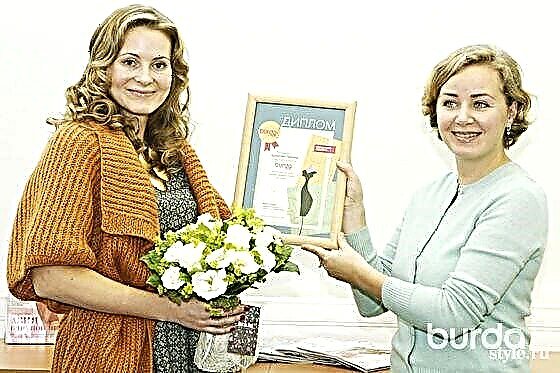The goal is to quickly lose weight before the New Year by 5-10% of your weight, but not to starve and do not deny yourself your favorite food.
Professor of Nutrition, Director of the Eating Behavioral Laboratory at the University of Pennsylvania, renowned nutritionist Barbara Rolls spent 20 years studying the process of saturation and its effect on appetite, and the development of obesity. Based on her research, she developed her own dietary technique - volumetric (from English volume - volume). Its effectiveness is that by choosing foods that contain fewer calories per serving, you can increase the amount you eat, but also reduce the total calorie content of the diet.
According to a study published by Barbara Rolls in 2011 in the American Journal of Clinical Nutrition, people who eat snacks 25% vegetables before meals eat 360 kcal less. That is, in fact, the more food we eat, the sooner we curb our appetite and the less calories we end up with. And if after a meal we experience a pleasant feeling of satiety, then the more chances we have to adhere to such a diet on an ongoing basis. At the same time, it is completely optional to refuse your favorite dishes. Just need to know the measure. Such a measure in the volumetric measure is the calorie density indicator, that is, the number of calories per 100 g of product (kcal / g).
For instance.One cup of raisins contains 434 kcal, and a cup of grapes contains only 104 kcal, i.e. raisins have a higher calorie density than grapes: 2.6 versus 0.6. What does this mean in practice? Fresh berries can be eaten without any damage to the figure three times as much as dried. Using a calorie density indicator in everyday life is fairly easy. It can serve as a guide when choosing certain products. Food, whose energy value is much less than weight, can be included in the diet without restrictions: this is the majority of fruits and vegetables. If the calorie density is from 0.6 to 1.5, that is, such products are possible, but in a reasonable amount, without overeating, this applies to cereals, lean meat, low-fat dairy products. You can eat food with a calorie density of 60 to 150 kcal per 100 g and at the same time lose weight or maintain weight depending on the level of physical activity and metabolic rate. But with foods that contain several times more calories than the portion weight (with a density of 150 kcal per 100 g): cheese, fatty meat, bread, sweets - you should be careful. Such “dense” food should be limited and compensated for by a large amount of food with a low calorie density. Dr. Rolls also advises you to monitor the total daily calorie intake. It depends on age and should not exceed: at 21−25 years - 2 thousand kcal, at 26−50 years - 1.8 thousand kcal, in 51+ - 1.6 thousand kcal.
FOOD ELEMENTS
Three factors affect the calorie density of a product: water, fiber, fat.
WATER is the main component.It gives volume to food and does not contain calories. For example, a grapefruit consists of 90% water, in a half of the fruit (1 serving), only 39 kcal; carrots - 88%, half a cup of carrots - it's only 25 kcal. The basis of volumetrics is precisely liquid and moisture-rich food: soups, fruits, vegetables.
CELL not only gives the food volume, but also is slowly digested, which means it provides a more complete and long saturation with a minimum of calories. Fiber is rich in the same vegetables and fruits, as well as cereals.
FATS have the highest calorie density: 9 kcal per 1 g. This is twice as high as that of proteins and carbohydrates. For example, 1 tea. a spoonful of butter contains as many calories as 2 cups of broccoli.
VOLUME RULES
EAT VEGETABLES OR FRUITS FOR ANY FOOD. The juicier they are, the better. Even if you increase the amount of food at the expense of vegetables three times, you will still lose weight! However, remember that without restrictions, vegetables can only be consumed without fat.
EAT ... BEFORE FOOD. Start with a dish that takes up a fair amount in the stomach: soup or salad. Soup can be vegetable, on a weak broth. Salad - for lunch and dinner, vegetable, for breakfast fruit.
ENJOY THE VIEW OF A FULL PLATE. At the same time, a signal about pleasure immediately enters the brain, and where there is pleasure, there is no risk of overeating.
DO NOT REFUSE PROTEINS. Proteins give longer saturation. In addition, low-fat protein foods do not threaten the appearance of excess weight. The role of a complete protein in the diet can be milk with morning granola, beans or tofu in a salad, a piece of fish, turkey, beef for lunch or dinner.
VLUMETRIKI DAY MENU
BREAKFAST: granola or cereal (in skim milk or water) with fruits / berries, which should be about half the first and main meal of the day.
SECOND BREAKFAST: low-fat yogurt, some fruit and a slice of cheese.
LUNCH: lean vegetable soup, lean meat and steamed vegetables in the oven or boiled.
DINNER: fish, for example, with wild rice and stewed non-starchy vegetables with a low calorie density, they should replace half the usual portion of the side dish.
Snacks: diet cottage cheese, low-fat cheese, fruits, diet bread.
BEVERAGES: mineral water, green tea, freshly squeezed juices, fruit and milk shakes.
 The article was published on the materials of the magazine "Good advice" 11/2013
The article was published on the materials of the magazine "Good advice" 11/2013
Text: Leah Radova. Photo: PR
Material prepared by Julia Dekanova



